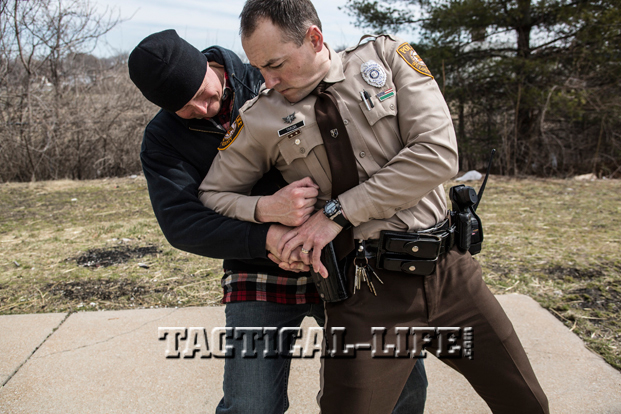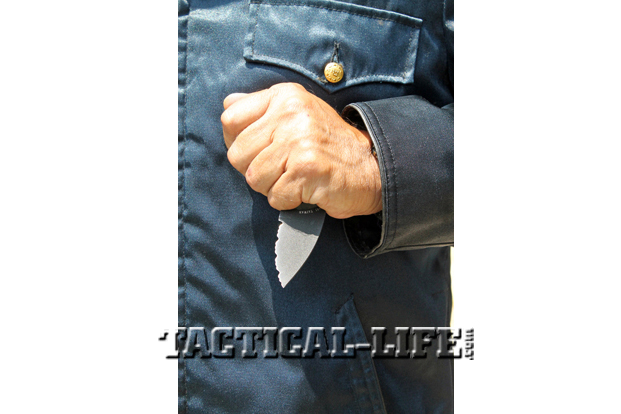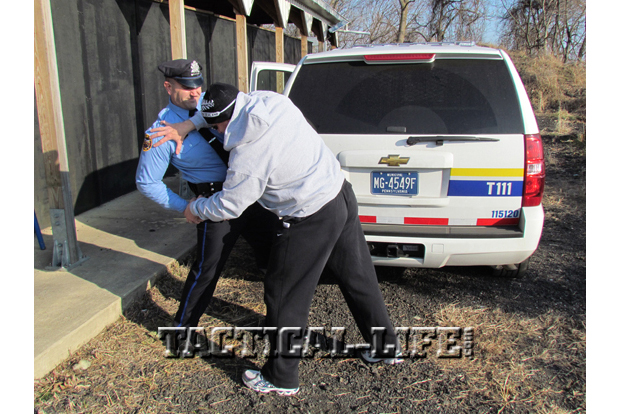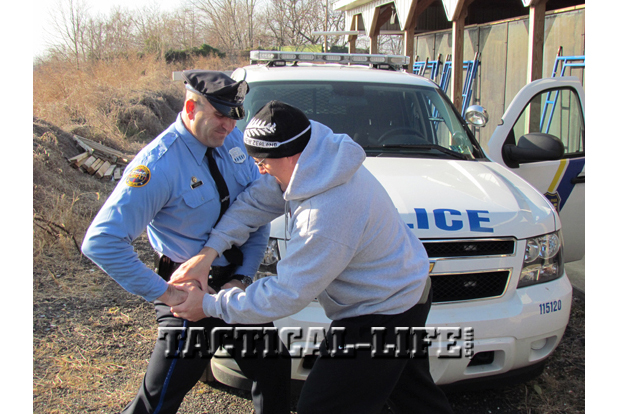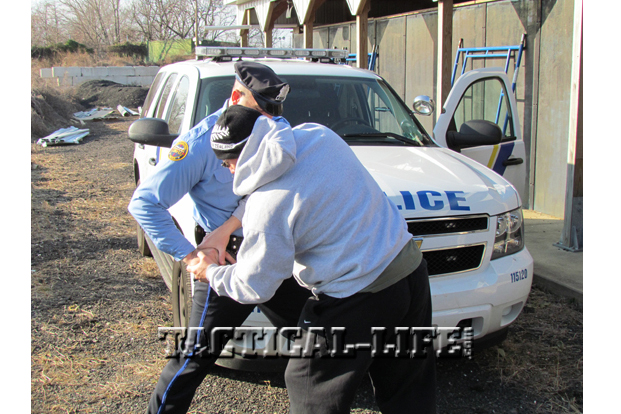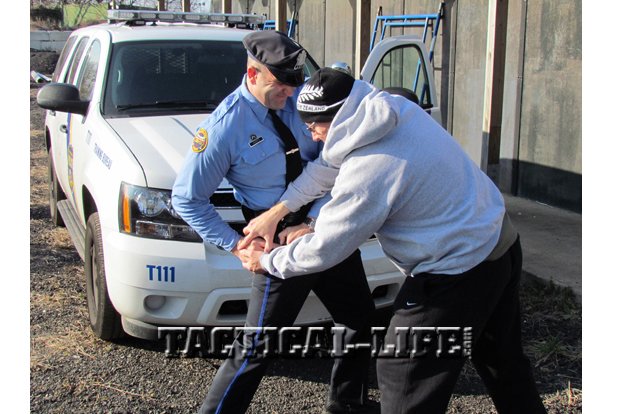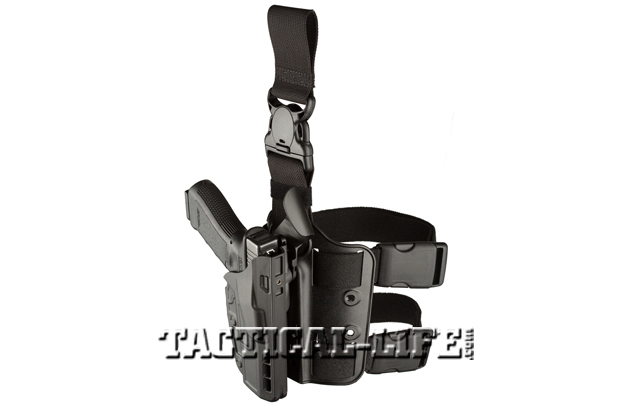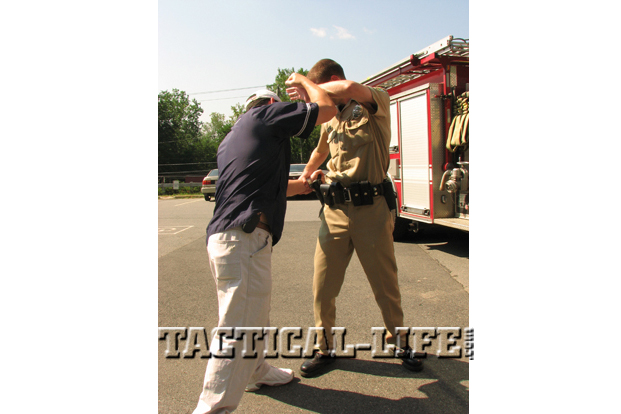The first responding officer, as we’ve said here many times, is often the only officer present at the scene of trouble. If the suspect goes for his gun, that cop is likely on his own. Let’s review some street-proven approaches to preventing homicidal disarms of police.
Case One occurred in New England. Two suspected terrorists fleeing after the Boston Marathon bombing have only one gun between them, so, to get another, they ambush and murder a policeman to steal his. However, they are unable to pull the dying officer’s pistol from its “triple-locked” security holster. The one suspect with his own gun dies in a shootout with police; when the other is captured later, he is unarmed and surrenders without resistance. Had the martyred patrolman’s weapon been in an ordinary holster, the last suspect might have been able to open fire on multiple officers with it when captured. The lesson: Preventing disarms saves other lives, beyond those of the originally targeted officer.
Bring Your Own Backup
Case Two took place in the Great Lakes area. A father-son team of felons disarmed a state trooper of his duty sidearm at gunpoint. But they did not realize the officer’s department requires every trooper to carry an issued backup gun. At an opportune moment, the hostage lawman turned the tables, drawing a snub-nose S&W revolver from his trouser pocket and taking the father at gunpoint as a human shield. The son surrendered, and the terrifying scenario ended without bloodshed. Backup handguns have saved police lives in many, many disarming situations around the country.
Advertisement — Continue Reading Below
In Case Three, a metro police officer was using a urinal in a public restroom when a perpetrator came up behind him and tried to snatch his Glock 22 out of its security holster. Trapping the suspect’s hand on the holstered gun with his dominant hand, the ambushed cop drew a backup knife with his free hand and literally carved the assailant off of him, ending the potentially
lethal assault.
For Case Four, we head to the Southwest. An officer was in a violent wrestling match initiated by the suspect he was attempting to arrest when the suspect gained control of the officer’s duty pistol. The cop shouted to his partner, “He’s got my gun! Shoot him!” The partner officer did exactly that. By the time the perpetrator let go of the police gun and collapsed, he had been shot three times and would not survive. Though a lawsuit is underway at this writing in the death of the suspect, law enforcement and the criminal justice system have already found Case Four to be a justified homicide.
Stronger by Design
Case Five occurred in the Midwest. A suspect suddenly attacked an arresting officer and snatched his duty weapon from its simple Level I safety-strap holster. The suspect immediately blasted the officer center-mass, and shortly thereafter, killed himself with the stolen police .357. The officer survived with only bruising, however—saved by the Second Chance vest concealed under his uniform shirt.
Advertisement — Continue Reading Below
While body armor is one failsafe, so are the designs of several currently issued duty handguns. Case Six took place in the Pacific Northwest. A suspect managed to rip a deputy’s pistol out of its holster. He pointed it at the officer and pulled the trigger—but the gun would not fire. It was a privately owned, department-approved 1911 .45 ACP, carried on “safe,” and the suspect could not find the safety catch. He fled, leaving the officer unharmed, and was captured later without further violence.
Case Seven occurred in the Rocky Mountains. A suspect overpowered and beat an officer, and gained control of his Smith & Wesson service pistol. However, the magazine-release button had been pressed, dropping the magazine and activating the magazine-disconnect feature. Though there was still a round in the chamber, it would not fire when the suspect tried to shoot the cop, who emerged battered but alive.
Finally, we have Case Eight, which occurred in the Southeast. An armed security guard was attacked by multiple assailants who tried to rip his Ruger out of its duty holster. However, the officer had been trained in the Lindell handgun-retention method, and successfully peeled the attackers’ hands off his weapon. He drew it himself and the suspects fled without a shot being fired. The Lindell method is believed to have saved as many police lives as body armor since the retention system was developed in Kansas City, Missouri, in the mid-1970s.
Advertisement — Continue Reading Below
It’s important to take a retention training refresher regularly, and remember to utilize security holsters, backup guns, backup knives and even backup officers. Also, body armor is always a final safety net. All of these factors have been documented as making the life-or-death difference when criminals attempt to disarm police with homicidal intent. The danger is obvious, but, fortunately, there are protective measures.
